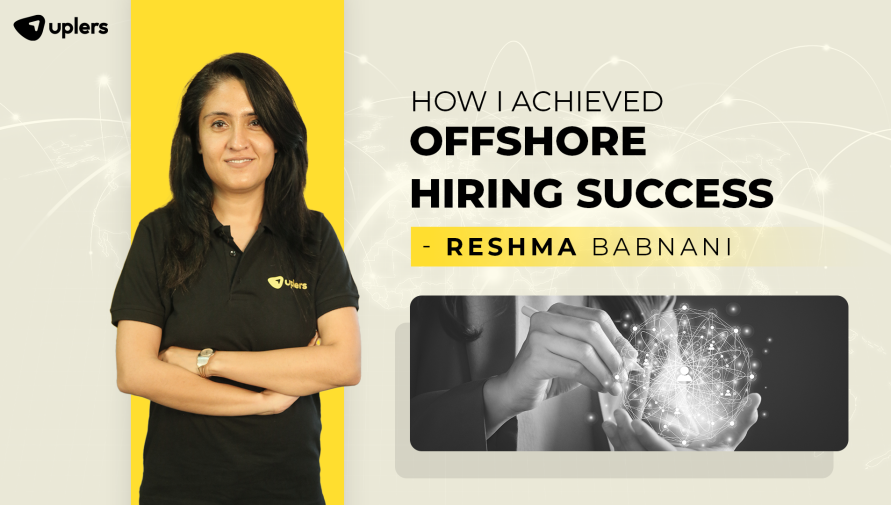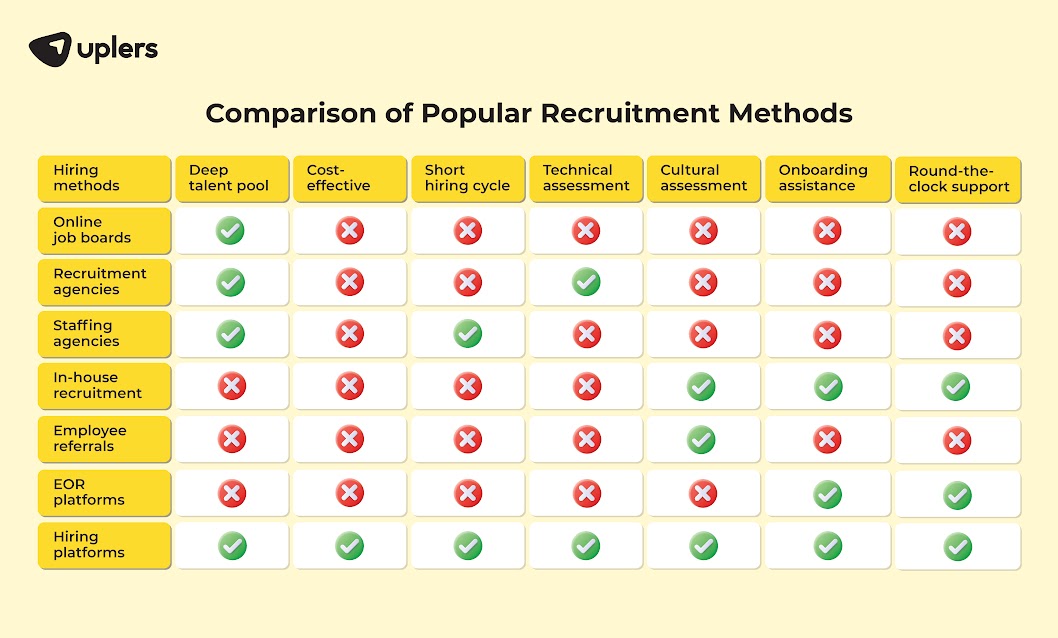A SaaS Leader’s Guide to Offshore Hiring Success
- Reshma Babnani
- November 3, 2023
- 5 Minute Read

As someone who has helped SaaS companies scale through effective hiring, I’ve seen first hand how offshore talent can transform businesses. With over 40% of SaaS companies in the US, Australia, and Europe now hiring offshore teams, the right strategy can give you access to diverse talent while optimizing costs. But not all hiring methods are created equal.
In this guide, I’ll share the pros and cons of different recruitment options, and why choosing the right one is critical for building a successful SaaS team.
A SaaS Leader’s Guide to Offshore Hiring Success
As someone who has helped SaaS companies scale through effective hiring, I’ve seen firsthand how offshore talent can transform businesses. With over 40% of SaaS companies in the US, Australia, and Europe now hiring offshore teams, the right strategy can give you access to diverse talent while optimizing costs. But not all hiring methods are created equal.
In this guide, I’ll share the pros and cons of different recruitment options, and why choosing the right one is critical for building a successful SaaS team.
Now, the question arises: how do you choose the right hiring method? With the plethora of options available for hiring your next offshore remote talent, the challenge here is identifying the one that’s right for you.
We will get to that, but first, let us discuss the seven most popular recruitment methods and their hiring process.
7 Popular Types of Recruitment Methods
- Online job boards and professional networks
- Recruitment agencies
- Staffing agencies
- In-house recruiting
- Employee referrals
- EOR companies
- Hiring platforms

Online Job Boards and Professional Networks
Platforms like LinkedIn, Glassdoor, and Indeed are great for quickly posting jobs and accessing a large talent pool. But they often lack the screening processes SaaS companies need.
My Take:
“These platforms deliver quantity, not quality. Without detailed vetting, you’ll spend time sifting through irrelevant profiles, and finding someone who fits your product and culture is tough.”
- Pros: Easy to use, quick to post jobs.
- Cons: No vetting, irrelevant profiles, and limited onboarding support.
Recruitment Agencies
Recruitment agencies can simplify the sourcing process by pre-screening candidates. However, they rarely dive deep into technical or cultural alignment, which are essential for SaaS companies.
My Take:
“Agencies save time on initial screenings but often lack the depth to understand SaaS-specific needs. For product-driven teams, that’s a deal breaker.”
- Pros: Pre-screened candidates, wide sourcing network.
- Cons: Expensive, limited focus on SaaS-specific roles, and no guarantee of cultural fit.
Staffing Agencies
If you need short-term or freelance support, staffing agencies work well. But for long-term SaaS roles, their limited vetting processes fall short.
My Take:
“Staffing agencies are a quick fix, but they don’t help build the sustainable, committed teams SaaS companies need.”
- Pros: Quick access to temporary workers.
- Cons: Unsuitable for long-term needs, no emphasis on cultural or technical alignment.
In-House Recruitment
Building an internal recruitment team offers full control over hiring, but it’s resource-intensive. For smaller SaaS companies, this can be a costly and time-consuming route.
My Take:
“In-house recruitment works for large enterprises, but for fast-scaling SaaS companies, it can slow you down and increase overheads.”
- Pros: Complete control, better cultural alignment.
- Cons: High costs, longer hiring cycles, and resource-heavy
Employee Referrals
Referrals can fast-track the hiring process with candidates who align culturally. However, they often limit diversity and reach.
My Take:
“Referrals are great for cultural fit, but they can narrow your talent pool and leave you missing out on diverse perspectives.”
- Pros: Quick hires, culturally aligned candidates.
- Cons: Limited diversity, geographically restricted
Employer of Record (EOR) Platforms
EOR platforms like Deel handle payroll, compliance, and onboarding for offshore hires. However, they don’t assist with sourcing or evaluating talent.
My Take:
“EOR platforms are great for administrative tasks but fall short on finding and vetting the right talent—something SaaS companies can’t afford to compromise on.”
- Pros: Simplifies compliance and payroll.
- Cons: No talent discovery or vetting support.
Hiring Platforms (e.g., Uplers)
Tech-enabled hiring platforms provide end-to-end solutions, from sourcing and vetting to onboarding and payroll. Their thorough evaluation processes ensure SaaS companies find the right fit.
My Take:
“Platforms like Uplers bridge the gap between speed and quality. Their deep vetting ensures that candidates are both technically skilled and culturally aligned.”
- Pros: Comprehensive hiring support, vetted candidates tailored to SaaS needs.
- Cons: Slower vetting process due to its thoroughness.

Where Traditional Methods Struggle
Identifying the Right Talent
Traditional methods often miss the mark when it comes to technical and cultural alignment.
Faster Hiring Cycles
Traditional hiring can take months. In a competitive market, that’s a luxury SaaS companies can’t afford.
Data-Driven Hiring
Many traditional methods lack tools like Applicant Tracking Systems (ATS), which streamline hiring and reduce administrative tasks.
Post-Onboarding Support
Seamless onboarding is key for long-term success, but traditional methods often ignore this step.
Choosing the Right Hiring Approach
The best hiring method depends on your priorities. For quick sourcing, job boards and agencies might work. But for end-to-end support with deep vetting and onboarding, platforms like Uplers are your best bet.

Why Offshore Hiring is a Game-Changer for SaaS
Hiring offshore talent allows SaaS companies to build diverse, high-performing teams without breaking the bank. However, as Reshma pointed out:
“Success depends on finding talent that aligns with your product and culture. A generic approach won’t work.”
- Online Job Boards and Professional Networks
Platforms like LinkedIn, Indeed, and Glassdoor provide massive internal networks to source talent quickly. However, these platforms often lack detailed vetting processes and comprehensive onboarding support, which are critical for SaaS companies looking for specialized talent.
“Hiring platforms like LinkedIn allow mass applications, but this often means screening through irrelevant profiles. The challenge is not in finding talent but in finding the right talent that fits your product needs.” – Reshma Babnani
Pros: Quick sourcing, easy to post jobs.
Cons: No vetting, no onboarding, may attract inactive profiles.
2. Recruitment Agencies
Agencies handle initial screening and sourcing, but cultural alignment and deep technical vetting may be overlooked.
Reshma adds:
“Agencies often miss the mark on SaaS-specific needs. They lack the depth required for long-term cultural and technical fit.”
- Pros: Pre-screened candidates, wide sourcing.
- Cons: High costs, limited focus on SaaS needs.
3. Employee Referrals
Referrals help find culturally aligned talent quickly, but they might limit diversity and global reach.
Reshma notes:
“While referrals bring fast results, they often don’t deliver the diversity SaaS companies need to innovate and grow globally.”
- Pros: Culturally aligned hires, cost-effective.
- Cons: Limited diversity, smaller talent pool.
4. Hiring Platforms like Uplers
Hiring platforms provide end-to-end solutions, from talent discovery to onboarding and payroll management.
Reshma says:
“Platforms like Uplers combine speed and depth. Their thorough vetting ensures SaaS companies get candidates who are technically and culturally ready to hit the ground running.”
- Pros: Comprehensive hiring support, vetted candidates, tailored for SaaS.
- Cons: Best for full-time roles; thorough vetting may take more time.
The SaaS Advantage with Modern Hiring
1. Faster Hiring Cycles
“Traditional hiring can take 30-60 days, but dynamic platforms cut this to under 10 days,”
2. Data-Driven Decisions
“A good ATS streamlines recruitment and provides analytics for smarter hiring,”
3. Retention Through Better Onboarding
“Onboarding is key. A smooth process boosts productivity and retention—critical for SaaS growth,”
Takeaways for SaaS Companies
- Choose Platforms That Understand SaaS Needs: Use solutions like Uplers for tailored hiring.
- Focus on Quality Over Speed: Vet candidates thoroughly to ensure long-term fit.
- Leverage Data: Invest in tools that make hiring smarter and faster.
- Don’t Ignore Onboarding: Ensure new hires are set up for success from day one.
The Future of SaaS Hiring
“Finding the right talent is key to scaling your SaaS business. Whether you’re hiring locally or offshore, a focused, efficient approach will give you the competitive edge.”
Ready to build your dream SaaS team? Start with a hiring method that fits your goals and watch your business grow.

Thank you for submitting the details!
We will keep your information safe. Feel free to contact us with any questions at hello@uplers.com
Please check your email for next steps shared by Robert.

















